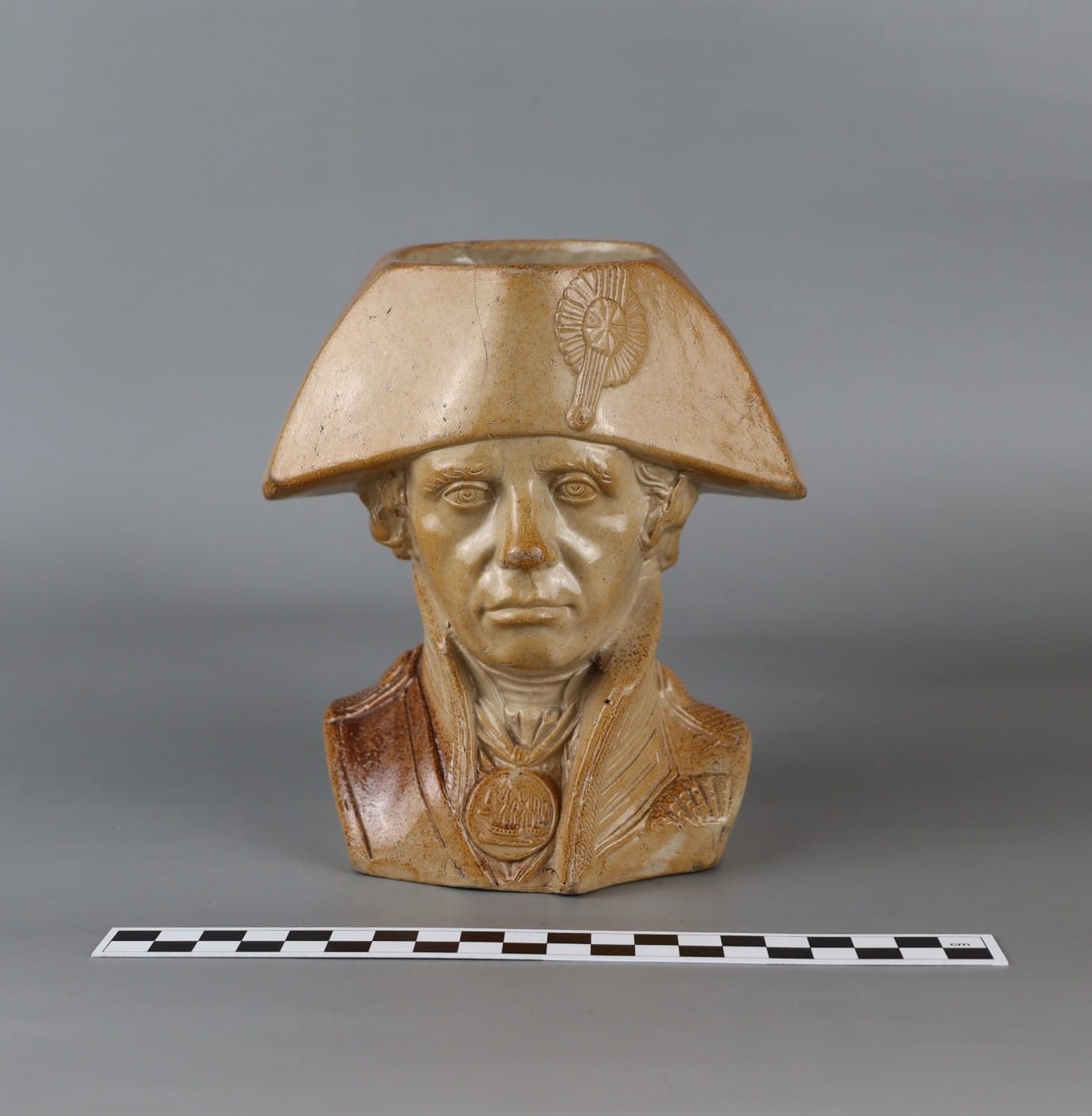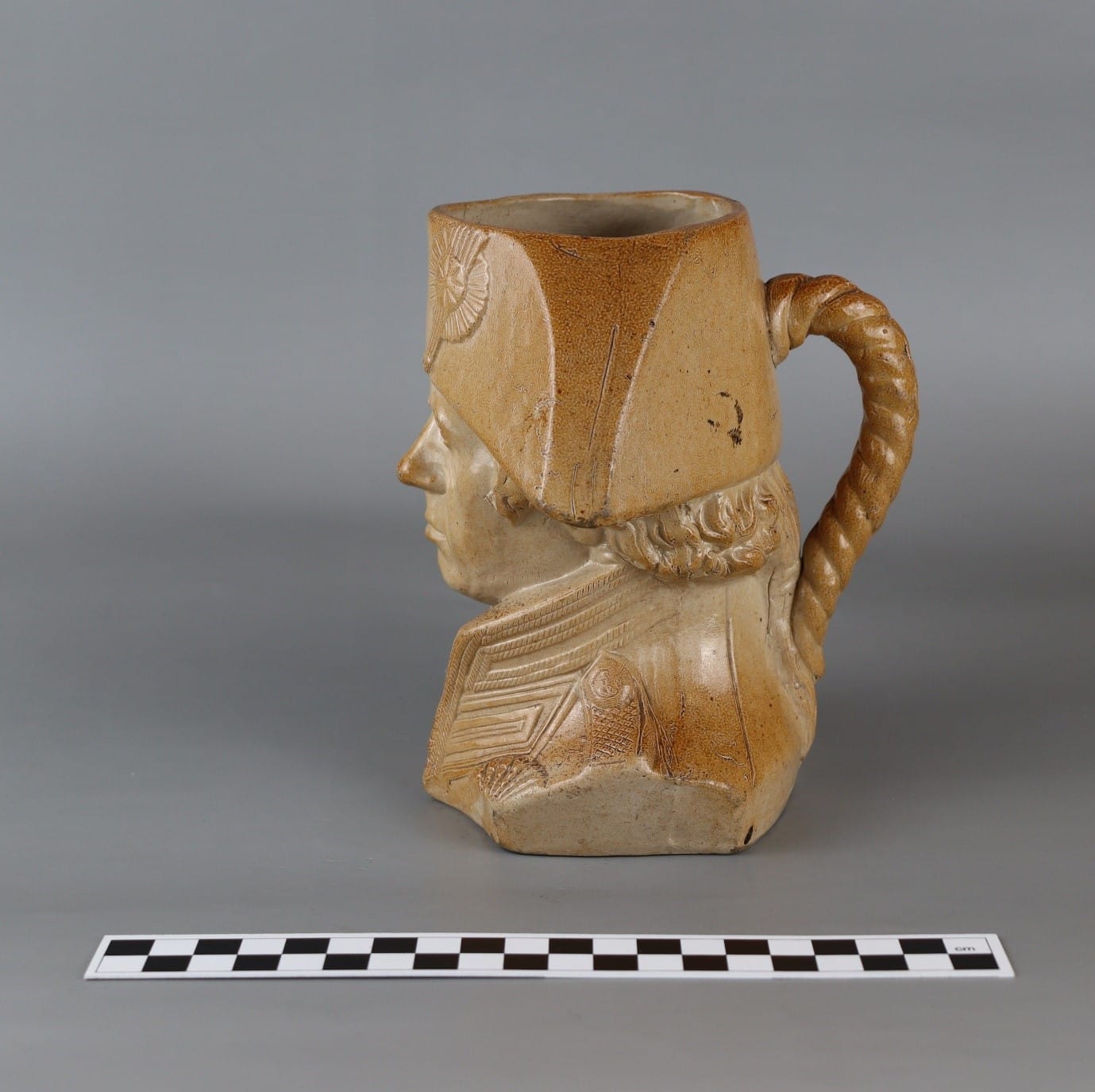Hampshire Cultural Trust has received funding from National Lottery Heritage Fund to help reimagine the Allen Gallery and its nationally significant ceramic collection over the next year. As a part of this project, we are researching and discovering the collections’ untold stories.
This month’s object is a stoneware jug in the form of Admiral Lord Nelson.
Commemorating a naval icon
Face on, this ceramic object looks like a small statue, however a closer look reveals it’s a salt-glazed stoneware jug, featuring a portrait bust of Admiral Lord Nelson, who died in 1805. Manufactured 15 years after his death, memorabilia featuring this naval hero was produced for decades, a sign of the great esteem the British people had for him. The rope handle on the jug is a decorative touch that was probably inspired by the ropes used on the ships of that era, and a closer look reveals ships on the medallion hanging around his neck, possibly representing the Royal Navy ships at Battle of Trafalgar.
This jug is described as salt-glazed stoneware, which means that before the clay was fired at a high temperature, common salt was thrown into the kiln. Sodium in the salt reacts with silica in the clay to form a glassy coating of sodium silicate, producing a translucent glaze with a slight orange-peel texture. Whilst this process was popular in Europe from the 15 to the 19th centuries, due to concerns around air pollution its use has almost completely disappeared. It was thanks to Bernard Leach in the first half of the 20th century that salt-glaze was promoted to studio pottery and continues to be used today.

A plethora of commemorative memorabilia exists to celebrate the successes and achievements of Admiral Lord Nelson, including mugs, figurines, trinket boxes, medals and coins. All around the UK and abroad, monuments exist to honour him. However, it was not until 1843, that an outdoor public memorial was erected. Funded by public subscription, the famous Nelson’s Column was erected in Trafalgar Square in London.
Nelson is probably remembered by most people today for his defeat of Napoleon Boneparte at the Battle of Trafalgar in 1805, a victory that ended all Napoleon’s thoughts of invading Britain. Although this victory made him a heroic figure, Nelson’s rise through the ranks of the Navy is equally impressive.
Born in Burnham Thorpe, Norfolk on 29 September 1758, to a clergyman, Nelson was one of 11 children. At the age of 12, he joined the navy on a ship under the command of one of his uncles. By the time he was 20, he had risen to the position of a captain. His voyages at this time included the West Indies, Canada and the Baltic Sea.
In 1793, Nelson was given the command of the ship, Agamemnon during the French Revolutionary wars and saw active service in the Mediterranean. He was heavily involved in the capture of the island of Corsica from the French in 1794.

Lord Nelson suffered some notable injuries during his time at sea: he was partially blinded in the capture of Corsica and in 1797 he lost his right arm in the battle of Santa Cruz de Tenerife.
Probably Nelson’s most famous achievement today is his victory at the Battle of Trafalgar (1805). It commenced on 21st October 1805 with Admiral Lord Nelson, on board the flagship HMS Victory, giving his famous flag signal to his fleet “England expects every man will do his duty.” This was to be his last battle as he was fatally wounded on deck by a French musket ball. He was injured at about 1.15pm but died approximately three hours later as nothing could be done to save him. However, he lived long enough to hear that Britain had been victorious against her enemies.
A barrel of rum was used to preserve Lord Nelson’s body so it could be transported back to London on HMS Victory, for his funeral. As befitted a national hero, Admiral Lord Nelson was given a lavish state funeral and buried in St Paul’s Cathedral.
His death came as a great shock to the British nation, but his achievements were celebrated and remembered annually by the public on Trafalgar Day with dinners, parades and parties throughout the 19th century and with memorabilia such as our stoneware jug.
With research contributions from Karen Stewart, Ceramic Research Volunteer.




